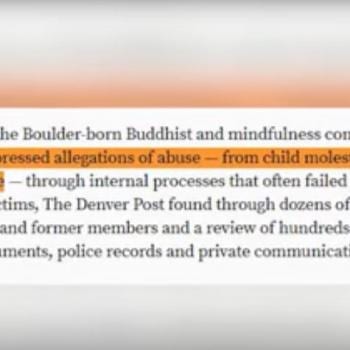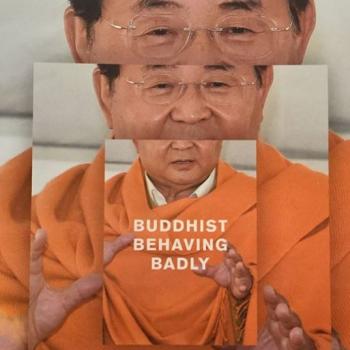Subtitled “Memoirs of a Modern Dharma Pioneer,” Charles Prebish’s latest book is a tour de force of American Buddhist studies. While I give it 5 of 5 stars, it won’t be a book for everyone. As memoirs go, it is excellent: comprehensive, revealing, honest, and straightforward. But unless you’re in one of the relatively small fields of American Buddhist Studies or Buddhist Ethics, Charles Prebish might be little more than a curiosity to you.
But, if you’re like me, and immensely interested in both American (or Western more broadly) Buddhism and Buddhist Ethics, then this book is a must read. This book also brings us inside academia and Buddhist Studies like no other book out there.
The topics of the book basically break down into three areas:
- The Man
- The Discipline
- The Subject
As a young scholar, having just dipped my toes in the proverbial pond of Buddhist academia, I read with a great deal of empathy and understanding about Chuck’s early career in the Discipline of Buddhist Studies. For reasons I won’t get into here, being a Buddhist and a scholar of Buddhism today isn’t always very easy. Speaking of his early years as a professor he says, “…people would react better if I said I was gay than if I said I was Buddhist.” (p.37)
It’s true. Luckily, with the help of great scholarship by more “openly Buddhist” scholars (or “scholar-practitioners,” a term Prebish coined in the early ’90s), more academic departments are becoming friendly to the idea that one can be both a Buddhist and a good scholar. Speaking to a Zen teacher of mine a couple years ago, I related the difficulty an academic friend of mine had faced with his department. He was criticized for discussing his own practice in the classroom. The Zen teacher quizzically replied, “wouldn’t they want someone who had been swimming before to teach swimming?”
It came to me shortly later, on the other hand, that departments wouldn’t want people who had practiced cannibalism teaching the anthropology courses that covered such material. In any case, I’ve had great luck so far, amazing teachers, good support, and only one “higher-up” treated me as if I were some sort of cannibal. Young scholar friends of mine have had the full gamut of experiences. As Prebish writes, “It’s no wonder that Buddhist Studies is known as a discipline that devours its own young … whole and live.” (p.61). To quote my own margin notes there: “Yikes!!!” Chuck reveals his optimism that the discipline might become a kinder place as more scholar-practitioners enter the field. (p.82) I hope he’s right. He points to Rev. Danny Fisher both in the book and the talk below as a fine example of this and I agree.
Prebish’s groundbreaking work both re-imagined the formation of Buddhist ethics in early mainstream Buddhism, looking both at early Vinayas and sectarianism, and he created the most widely used and understood typology of Buddhism in America: the “two Buddhisms” model, contrasting Asian, or immigrant/ethnic Buddhism, on the one hand and White, or convert Buddhism on the other. The former work on sectarianism (in part with Jan Nattier), while contested at first, has generally become the accepted model.
The “two Buddhisms” typology, on the other hand, has been a source of dispute ever since it debuted in 1979. I spent three years working on the very wonderful “Buddhism in the West” consultation for the American Academy of Religion, and the vast majority of the papers there, it seemed, were discussions of this typology. Ironically, it was an excellent paper on Mahayana Buddhism that prompted some of my first coordinated thoughts on the “two Buddhisms” model, defending it for its utility:
Detractors of the model focus on its flaws, sometimes to the point of no longer seeing its usefulness. When I taught Intro to Buddhism to college students, I used this model – basically. For two days I described the “Two Buddhisms” as relatively separate and determinable categories, and then on the third day I showed the problem with the model. It was a very useful tool for introducing Buddhism in the West to new students.
That was two years ago and much has been contributed to the field. However, I’m pretty sure I would still use the model if I were teaching a course in the near future. I should note that I generally teach in a historical manner. So describing how the model was, for example, extremely accurate at one time, and then began to crumble more and more, would, I hope, be consistent with all of the wonderful new contributions in this area of study. Things change. The utility of labels comes and goes. This is a teaching throughout Buddhism, and should not come as a shock to scholars of Buddhism. As Chuck laments though, some scholars try to revise history and claim that the model was never useful.
Two more areas of pioneering work that Prebish has been responsible for include Buddhist ethics and the use of the internet for scholarship. Readers of the book will get a rare, insiders look at the founding of the first ever electronic journal in Religious Studies, the Journal of Buddhist Ethics. Following its success, the Journal of Global Buddhism was launched, as well as the JBE e-books website. These accomplishments, along with a complete chapter devoted to the current state of the art in North American Buddhist studies, are detailed in this excellent book.
Chuck Prebish has indeed been a pioneer, in more ways than one, and it is hoped that his work – and those inspired by it – continue indefinitely into the future. This book gives us a clear map of the efforts of the past, and an important glimpse into that future. You can purchase a copy via amazon or find out more from the publishers at Sumeru Books.











